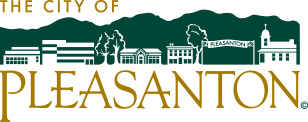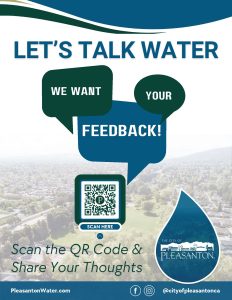- Public Works
- Divisions
- Customer Service
- Utility Billing
- Pleasanton Water
- Water Conservation
- Water Rates
- Rebates & Services
- Clean Water Program
- Recycled Water Program
- Regional Groundwater Facilities Project
- Near-Term Water Improvement Projects
- Street Sweeping
- Engineering
- Development Services
- Landscape Architecture
- Tree Removal
- Projects
- Integrated Pest Management
- Floodplain Management
- Emergency Preparedness
- Contact Us
Pleasanton Water
The City of Pleasanton operates and maintains a water distribution system to deliver water to city residences and businesses, as well as for other uses such as firefighting.
Water & Sewer Utility Bill
For more information on how to pay your water & utility bill, visit the City’s Utility Billing page or call (925) 931-5500.
Alameda County’s Zone 7 Water Agency is the Tri-Valley’s water wholesaler that procures water from the state and produces water from its regional wells, which it sells to Pleasanton and other Tri-Valley water retailers for distribution. Pleasanton is a unique retailer in that in addition to buying water from Zone 7, it also has local groundwater wells that have the capacity to deliver 3,500-acre feet per year, which is approximately 20-25 percent of all water delivered within Pleasanton.
In addition to its water distribution system, the City offers a variety of water conservation programs to promote the continued importance of conservation by residents and businesses. Water conservation is a way of life in California and the City of Pleasanton is committed to promoting responsible and efficient water use now and in the future.
Stay Informed: Pleasanton’s Water System Management Plan Featured in Hacienda Newsletter
The City of Pleasanton’s commitment to water sustainability and infrastructure improvements is making headlines!
Check out the latest Hacienda Newsletter feature highlighting our Water System Management Plan and how it enhances efficiency, conservation, and long-term resilience. Hacienda Newsletter -City of Pleasanton Unveils Water System Management Plan

March 1, 2025 Pleasanton Water Open House Event Handouts & Resources
Thank you to all who attended our first-ever Pleasanton Water Open House. Below are links to many handouts and resources distributed during this event. We’d love to hear your feedback—click the image below to share your thoughts!
Utility Billing & Customer Service
- How to Detect Outdoor and Indoor Water Leaks
- Reading Your Water Bill
- Serving Our Customers (Pleasanton Water Portal)
Operations & Maintenance
Water Conservation
Cross Connection Control Program
Near-Term Water Infrastructure Projects
Planning for the Future of Water
Water Quality
The City’s goal is to continuously provide a dependable supply of high quality drinking water to its customers.Pleasanton’s Water Sources
Zone 7 Water Agency, the Valley’s water wholesaler, provides wholesale treated water to four major Valley water retailers, delivers untreated water to a number of agricultural customers, and monitors flood control measures and coordinates groundwater management resources in the Tri-Valley area. Approximately 80% of Pleasanton’s water is purchased from Zone 7 and is comprised of treated surface water blended with some local groundwater. The remaining 20% comes from local groundwater pumped from wells owned and operated by the City of Pleasanton. All water sources are disinfected and fluoridated before delivery to our customers.
2023 Annual Water Quality Consumer Confidence Report (CCR)
The technical and analytical water quality information presented in this Consumer Confidence Report (CCR) is required by State health regulations. These regulations require water suppliers to inform customers about where their water comes from, what is in their water, and any violation of safe drinking water standards that may have occurred during this past reporting period. This report provides the results of all tests required to be performed on Pleasanton’s water supplies during 2023. We are happy to report that all 2023 water quality tests confirmed that the water delivered to your tap met all applicable federal and state drinking water standards without any violations.
This report also includes information regarding steps taken by the City and Zone 7 Water Agency to improve drinking water delivered to customers in 2023, and opportunities for the public to participate in decisions that affect their drinking water quality. Phone numbers and web page addresses of the City and other public agencies responsible for water billing, delivery, supply and water quality are also presented herein.
Prior Year Water Quality Reports
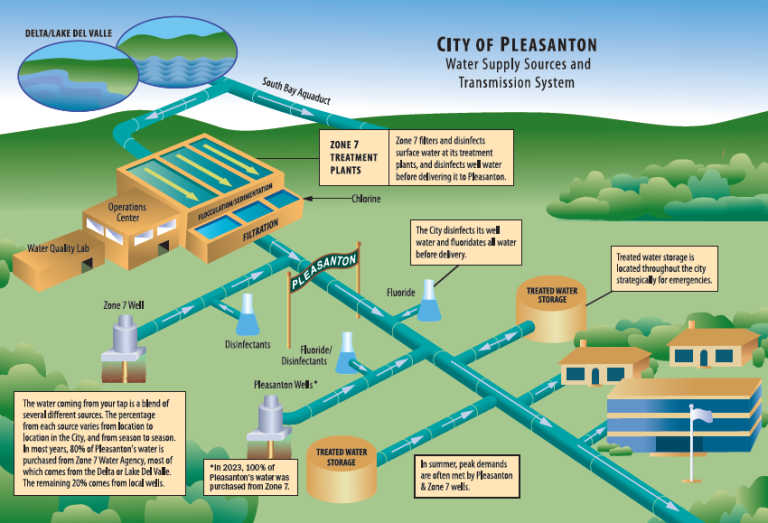
Water Supply and Quality Projects
The City has always met or exceeded state and federal drinking water regulations and will continue to do so in the future. The City is undertaking multiple actions to address water supply and quality now and in the long term to continue to deliver safe, reliable drinking water to its 22,000 customers.
Pleasanton Pipeline
The City has created a special edition e-newsletter series, the Pleasanton Pipeline to share information about water projects and initiatives going on in the City.
Subscribe to receive future editions of the Pleasanton Pipeline and other City Newsletters.
- View the first edition (August 31, 2023) Pleasanton Pipeline.
- View the second edition (September 14, 2023) Pleasanton Pipeline.
- View the third edition (October 5, 2023) Pleasanton Pipeline.
- View the fourth edition (October 13, 2023) Pleasanton Pipeline.
- View the fifth edition (November 21, 2023) Pleasanton Pipeline.
- View the sixth edition (December 21, 2023) Pleasanton Pipeline.
- View the seventh edition (June 7, 2024) Pleasanton Pipeline.
- View the eighth edition (August 23, 2024) Pleasanton Pipeline.
- View the latest edition (October 28, 2024) Pleasanton Pipeline
FAQs
Is the City using contaminated groundwater wells instead of continuing drought conservation?
When would we need groundwater from Wells 5 and 6 to meet water demands this summer?
How do we know that water coming out of the tap is safe to drink?
The City continuously monitors the safety of its drinking water and shares that information in its annual water quality report. This report summarizes the data collected from hundreds of laboratory samples taken every year.
Is our water demand expected to bounce back immediately to pre-drought levels?
What are the City’s next steps for addressing its water supply needs?
We’re already taking several actions to bolster our water supply. We’re making system enhancements to improve delivery of water for next summer’s peak demands. We’re also looking at options to improve the reliability of supplies while we address current and future regulations such as PFAS and other emerging contaminants. Once we finish that process in September, the City will adopt an improvement program and determine the best way to fund the design, construction and operation of the new facilities.
Planning/Projects
Quarterly Water System Project Updates
The City provides quarterly updates on all various water projects. Click the links below to find read each quarterly update.
July 16, 2024 – Water Activities Update
March 19, 2024 – Water Activities Update
- City Groundwater Supply Project Workflow
Water Supply Alternatives
Completed 2023
In September 2020, the City began the development of the PFAS Treatment and Wells Rehabilitation Project to address PFAS contamination and extend the life of the existing groundwater supply. This project was planned to rehabilitate/replace existing well facilities and construct a Centralized Treatment Facility for disinfection and PFAS treatment of groundwater before distribution. The preliminary cost estimate of the project was $46 million, although costs have likely risen due to inflation.
Given escalating project costs – likely more than the estimated $46 million – in September 2022, the City Council paused the PFAS Treatment and Wells Rehabilitation Project and authorized staff to proceed with performing a Water Supply Alternatives Study. Eleven alternatives were initially explored, and of those initial 11 alternatives, 4 were studied and compared more thoroughly, to identify the alternative (or combinations of alternatives) that can produce 3,500 acre-feet/year. The City Council selected a project to construct two new groundwater located outside of the influence of PFAS contamination as it provides the highest reliability and lowest cost. To view the final Water Supply Alternative Study, please click here.
The construction of the two new wells is expected to cost approximately $25 million and take three to four years to complete. The City is exploring cost-sharing possibilities with Zone 7 for the construction of these two new wells, and other funding sources for water supply and quality projects including working with state and federal legislators who have secured supplemental funding for PFAS projects and participating in a class action lawsuit against a company that created PFAS in the environment.
Regional Groundwater Facilities Project
On June 18, 2024, the City Council approved an agreement to partner with the Zone 7 Water Agency on Phase 1 (Feasibility) of constructing two new wells as part of a Regional Groundwater Facilities Project.
View the City’s Regional Groundwater Facilities Project webpage form more information about this project.
Water System Management Plan
- Establish policy statements and water program goals and performance metrics.
- Identify focus areas for upcoming agreement negotiations for water and recycled water supply.
- Perform integrative planning efforts including a regulatory review, a framework for an asset repair and replacement program, and developing data and energy management plans.
- Recommend programs to improve operations and maintenance of the water system and develop standard operating procedures.
- Prepare a 10-year Capital Improvement Plan that identifies, provides cost estimates, and prioritizes projects based on recommendations from the integrative planning studies including the Water Supply Alternatives study.
Distribution Network Improvements
Completion by end of 2024
The City is planning for $4 million in infrastructure improvements to improve delivery of water for 2024 summer peak demands, including projects such as turnout improvements and booster pump stations.
View an agenda report from March 19, 2024 approving plans and awarding a contract for Near Term Water Improvement projects (Stoneridge Dr, Sunol Blvd, and Turnout 4).
View an agenda report from January 16, 2024 approving plans and awarding a contract for Near Term Water Improvement projects (Bernal Ave water line and Turnout 1 improvements).
Recycled Water Master Plan
Completion in 2024-2025
The City will perform a Recycled Water Master Plan to determine feasibility of obtaining additional recycled water users to maximize the City’s available sewer source supply. Included in the plan would be the identification of recommended infrastructure improvements and estimated capital costs to support recycled water system expansion.
The Recycled Water Master Plan will support subsequent efforts in developing a 2025 Urban Water Management Plan, which assesses the availability and reliability of water supplies and current and projected water use to help ensure reliable water service under different conditions. Capital improvement recommendations will be incorporated into future updates to the 10-year Capital Improvement Plan.
Funding for Water Program Activities
In addition to supporting the ongoing operational and service costs of delivering clean, reliable water to customers, funding will be required for:
- Reserve replenishment to recover from the previous drought emergency and potential increased water supply expenses due to the loss of City’s groundwater wells, and increases in DERWA recycle water wholesale rates
- Rehabilitation/treatment of groundwater wells and/or or implementation of alternative water supply sources
- Enhanced capital infrastructure projects for regulatory compliance, service enhancements, and to address repair and replacement.
Water Rate Study
Phase 1 completion in November 2023
Phase 2 completion by mid-2025
Rates have not increased over the past three years. To support water program funding, Rates will be adjusted in a two-phase approach. The first phase is underway following Council approval on April 18, 2023, to help the City maintain adequate funding for short-term operations and maintenance of the water system, replenish the reserves to Council-approved reserve levels, and better position the City to begin design of priority projects/programs including improvements to increase capacity from Zone 7.
The second phase will incorporate a plan to implement long-term management of the water system program including resources and the 10-year Capital Improvement Plan.
Financial Plan
Completion in early 2024
The City will update the water financial plan that evaluates annual costs to meet expected operational service levels and to implement a 10-year Capital Improvement Plan (CIP). The financial plan will consider financing options for the selected Water Supply Alternative and potentially other large capital projects recommended by the Water System Master Plan. The financial plan will be the basis for establishing budgets within the City’s two-year budgeting process and for setting water rates and connection fees. The financial plan will also consider increasing the fund balance for the recycled water funds to be less dependent on the potable water funds for contingencies.
Additionally, the City will conduct a resource evaluation that includes staffing, contractor support, vehicles/equipment and software. The resource evaluation would balance program goals/level of service with funding and will be coordinated with the water system financial plan.
Water Connection Fees
Completion by end of 2024
Water connection fees have not been updated since the 1980s and require adjustment based on the 10-year Capital Improvement Plan and, in particular, the recommended capacity improvements to support future growth.
Water Improvement Project Financing Option
The cost to upgrade and modernize infrastructure projects is too great to accomplish with funds on hand. The City has worked with a consultant to review three funding options:
- Publicly sold debt (bonds)
- A State subsidized loan through the California State Water Resource Control Board (SRF)
- A below market rate loan through the California Infrastructure and Economic Development Bank (IBank)
Pleasanton Water Improvement Project Financing Options
On May 7, 2024, the City Council approved the execution of a $19 million water revenue bond to assist in financing improvements to the City’s water system.
Water Rates
New water rates will go into effect on January 1, 2025. For more information about the new water rates, click here.
PFAS Information
Addressing PFAS in the City of Pleasanton
PFOA and PFOS are fluorinated organic chemicals that are part of a larger group of chemicals referred to as per-and poly-fluoalkyl substances (PFAS). PFOA and PFOS have been extensively produced in the United States since the 1940s. These man made substances have been synthesized for water and lipid resistance and used in products such as carpets, clothing, fabrics for furniture, paper packaging for food, non-stick cookware, and fire-retarding foam. Between 2000 and 2002, PFOS was voluntarily phased out of production in the U.S. by its primary manufacturer.
Is Pleasanton’s Water Safe?
What are PFAS?
How are people exposed to PFAS?
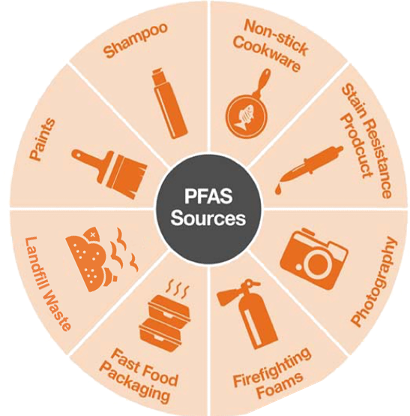
How does PFAS get into drinking water?

PFAS can contaminate drinking water supplies when products containing them are used or spilled on the ground and PFAS migrates into groundwater. Once in groundwater the substances can travel large distances and can contaminate drinking water wells. PFAS can similarly contaminate drinking water by entering lakes and rivers that are connected to drinking water supplies. The major sources of PFAS contamination in drinking water are believed to be from fire training/fire response sites, industrial sites, landfills and wastewater treatment plants/biosolid facilities.
What are the health effects related to PFAS exposure?
The industry’s understanding and ability to detect PFAS in the environment has evolved and we are now able to measure extremely small amounts (parts per trillion in water) of a number of PFAS and newer studies suggest that long-term exposure to PFAS in this range might affect the most vulnerable members of the population.
Although more research is needed, scientific studies indicate that exposure to PFAS can lead to significant health effects, especially in pregnant women or women likely to become pregnant and in children. Studies also show that PFAS may affect growth, learning, and behavior of babies and older children, affect the immune system, increase cholesterol levels, and increase cancer risk.
How is PFAS in drinking water regulated?
Federal Guidelines
The U.S. Environmental Protection Agency (EPA) has issued health advisories for certain PFAS. These health advisories can be found at the following link: EPA Health Advisories.
Additionally, the EPA is in the process of establishing federally enforceable drinking water standards for PFAS nationwide. View the EPA’s proposed PFAS regulations.
State Guidelines
The California State Water Resources Control Board (SWRCB) requires testing on a quarterly basis to identify the extent of contamination of drinking water sources in the state.
The California State Water Resources Control Board (SWRCB) has also issued drinking water advisory levels for certain PFAS as noted in the table below and is pursuing advisory levels for additional PFAS. Additionally, the SWRCB is in the process of establishing enforceable drinking water standards for PFAS.
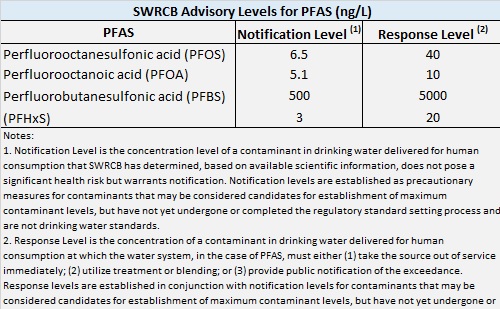
Where does Pleasanton’s drinking water come from?
The City owns and operates its own water distribution system that distributes approximated 4,500 million gallons of treated water a year to 22,000 customers. The City normally purchases approximately 80% of its potable water supply from the Zone 7 Water Agency, while the remaining 20% is supplied by city owned and operated groundwater wells.
Does Pleasanton treat water from its groundwater wells for PFAS?
Where can I find PFAS test results for Pleasanton's water?
How frequently does Pleasanton test water from groundwater wells?
The state requires water suppliers to test for PFAS quarterly.
What is the turnaround time to get PFAS test results?
What is the status of Pleasanton’s groundwater wells?
Pleasanton currently has three groundwater wells that it operates – wells 5, 6, and 8.
Wells 5 and 6 are still “In Service” with the SWRCB since currently below response levels, but have not been in operation since November 2022 after testing showed PFAS above the notification level, but below the response level. In summer 2023, wells 5 and 6 will be used as needed during peak demand.
Well 8 was placed in “Standby Service” with the SWRCB in June 2019 due to PFOS concentrations being above the response level at that time. The well has not operated since June 2019.
Does Pleasanton test Zone 7’s water when it comes into our system?
Is Zone 7’s water safe?
Zone 7’s water is safe. No PFAS have been detected in treated surface water supplies which is typically the majority of the total water delivered to its customers.
There have been detections in some of the groundwater wells. In the instances where these contaminants have been sampled above response levels in Zone 7 wells, Zone 7 has taken steps to treat the contaminants to concentrations below the response level in all water delivered to customers.
What is the status of PFAS at Zone 7?
A summary of PFAS test results for Zone 7 can be found at the following link: PFAS Test Results.
Zone 7 has been blending groundwater wells and/or treating groundwater at its Mocho Groundwater Demineralization Facility so that all drinking water is below Response Levels before being delivered to Pleasanton’s water distribution system.
Does Zone 7 test and treat its water?
Wells that have tested above the response level and that do not have current treatment options have been temporarily taken out of service while treatment facilities are constructed. Zone 7 is currently constructing water treatment facilities that utilize ion resin exchange to address PFAS at the Chain-of-Lakes and Stoneridge Well sites.
How is Pleasanton addressing PFAS?
Can I treat my water for PFAS at home?
Home water treatment can be installed to reduce levels of PFAS. Treatment can be at the point of use (kitchen sink, refrigerator, etc.) or at the point of entry (where treatment occurs for all the water entering your home). The two suggested effective home treatment systems for reducing PFAS are granular activated carbon (GAC) treatment systems and reverse osmosis (RO) treatment systems.
Granular activated carbon treatment system
- Physical filter cartridge traps contaminant(s) which is then removed and disposed of at the end of its rated lifecycle.
- A filter must be replaced on a regular schedule (identified by manufacturer).
- Generally easier to install, lower initial cost, and provides more water flow than reverse osmosis systems.
- May not effectively treat shorter-chain PFAS (if present) in addition to the longer-chain PFAS such as PFOA and PFOS.
Reverse osmosis treatment system
- Systems force water through a membrane under pressure, leaving the contaminants at the membrane.
- Typically requires pre-filtration to be installed to remove any sediment and small particles to maximize the life and effectiveness of the membrane.
- Membranes and any pre-filtration cartridges must be replaced on a regular schedule (identified by manufacturer).
- Large volumes of water are wasted in the treatment process.
- Research has shown potential to effectively reduce shorter-chain PFAS in addition to the longer-chain PFAS such as PFOA and PFOS.
How do I know if my home water treatment is working?
The best way to know if your home treatment system is effective is to make sure that it is tested by an independent third party. The packaging for the filter will typically contain this information. This information can also usually be found on the manufacturer’s web page. Make sure that the filter has been tested using a NFS standardized methodology such as NSF/ANSI Standard 53 Drinking Water Treatment Units.
What are the best filters for removing PFAS?
One way to reduce PFAS in your home is to use a water filter rather. But with so many filters on the market, and many marketing claims about eliminating PFAS, it can be hard to know which one is best for your home. The Environmental Working Group has issued a press release regarding tests they conducted on the effectiveness of ten different pitcher filters to remove PFAS from drinking water.
Where can I find more information?
Additional information is available at:
Zone 7 Water
California Water Board – PFOA & PFOS
EPA – PFAS
For more information, contact the City of Pleasanton Public Works Department by calling (925) 931-5500.
